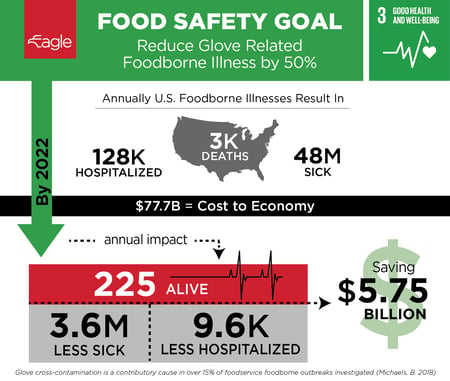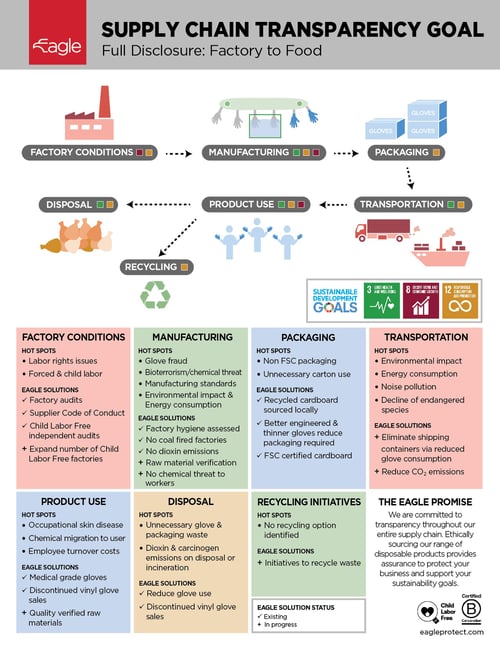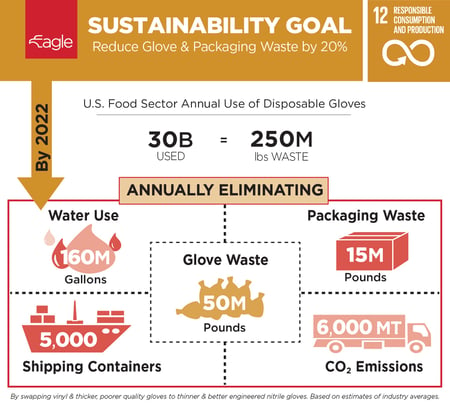In 2015 the United Nations adopted 17 global Sustainable Development Goals (SDGs) as part of the 2030 Agenda for Sustainable Development. The goals and associated targets are calls to take action to end poverty and hunger, protect the planet from degradation and climate change and ensure all humans can enjoy prosperous and peaceful lives in inclusive societies.
Covering social, environmental and economic challenges, all countries and all stakeholders are urged to take part to achieve the goals by 2030. Recognizing the impacts (both positive and negative) of our business on the planet is key to meaningful alignment with and action toward the SDGs and associated targets.
We have identified the following SDGs that most directly relate to our business and align with our strategic goals, and where we and our customers can make a significant impact:
-
SDG 3: Good Health & Well-Being
-
SDG 8: Decent Work & Economic Growth
-
SDG 12: Responsible Production & Consumption
SDG 3: Good Health & Well-being
Target 3.9: By 2030, substantially reduce the number of deaths and illnesses from hazardous chemicals and air, water and soil pollution and contamination.
Target 3.9.3: Mortality rate attributed to unintentional poisoning
Glove cross-contamination is a global issue and has been implicated as a contributory cause in over 15% of (foodborne) outbreaks investigated. There are an estimated 325,000 hospitalizations and 3,000 deaths due to foodborne outbreaks in the United States each year, estimated to cost $77.7 billion. Infection control management systems play an important role within the food and medical industries to minimize the risk of cross-contamination and pathogen infection.

How Eagle Is Achieving SDG 3
-
Eagle’s scientific research and R&D into the cross-contamination potential and food safety implications of disposable gloves.
-
Delta Zero testing of Eagle gloves to ensure against the risks associated with physical, chemical and microbiological hazards of disposable gloves.
Eagle Protect’s Goals
Through the use of quality nitrile gloves, by 2022:
-
Reduce the annual death rate in the US from foodborne illness by 225 people and the number of hospitalizations by 9,600.
SDG 8: Decent Work & Economic Growth
Target 8.7: Take immediate and effective measures to eradicate forced labor, end modern slavery and human trafficking, and secure the prohibition and elimination of the worst forms of child labor, including recruitment and use of child soldiers, and by 2025 end child labor in all its forms.
Target 8.8: Protect labor rights and promote safe and secure working environments for all workers, including migrant workers, in particular women migrants, and those in precarious employment.
The British Medical Association has highlighted disposable glove manufacturing should be considered at high risk of labor rights abuse, including child and forced labor, workers subjected to harmful chemicals and extreme health and safety violations.

How Eagle Is Achieving SDG 8
-
Eagle’s key glove manufacturers are Child Labor Free (CLF) certified through independent audits.
-
Eagle’s Supplier Code of Conduct measures labor conditions, environmental impact and quality control.
-
Full supply chain transparency to assess all Eagle products’ lifecycle.
-
Raw material verification of gloves - no chemical threat to factory workers or accidental or intentional contamination during the manufacturing process.
Eagle Protect’s Goals
-
Identify any negative work or economic effects on those involved in the supply chain, and provide solutions to address and measure these.
-
Increase number of CLF certified factories.
SDG 12: Responsible Production & Consumption
Target 12.5: By 2030, substantially reduce waste generation through prevention, reduction, recycling and reuse.
Target 12.6: Encourage companies, especially large and transnational companies, to adopt sustainable practices and to integrate sustainability information into their reporting cycle.
Glove consumption can be excessive due to poor quality raw materials and manufacturing processes, resulting in inferior quality gloves with high failure (ripping and puncturing) rates.
Globally 300 billion disposable gloves are manufactured each year. With around 60% of those used in the US, there is an opportunity for substantial waste reduction.

How Eagle Is Achieving SDG 12
-
Work with glove manufacturers to continually improve manufacturing standards and raw material formulation used during production, to produce stronger yet thinner gloves.
-
Review glove type, dispensing and processes to reduce glove consumption.
-
Swap customers from vinyl and thicker, poorer quality latex and nitrile gloves to thinner, stronger, better engineered nitrile gloves.
Eagle Protect’s Goals
-
Reduce glove and packaging waste by 20% through reduced glove usage (better quality, less failure) and corresponding disposal waste.
-
Provide our customers with personalized environmental impact savings focusing on waste, disposal, water and CO2 emissions.
-
Develop recycling initiatives.
-
Continue our leadership in the sustainable community and dedication to the B Corp certification.



